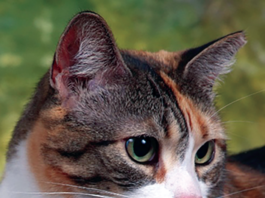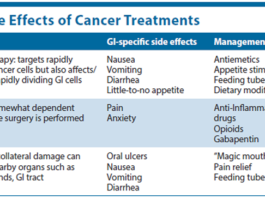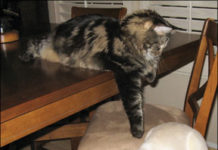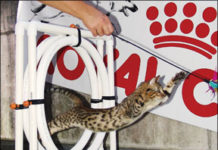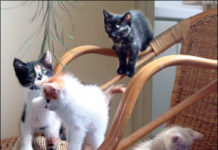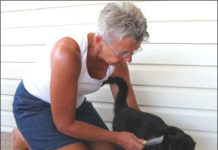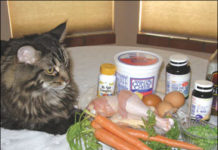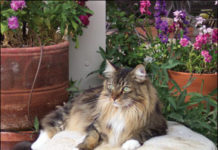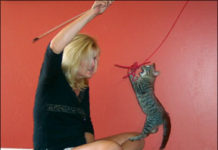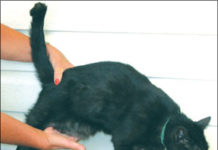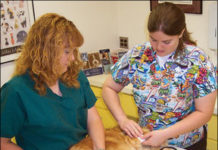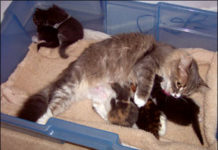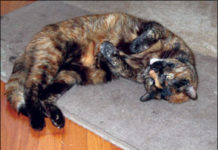Cat-Friendly Furniture
Several years ago, my cat and I moved in with my grandmother, relieving some financial stress for me and allowing my grandmother to remain independent as her health declined. Her house was filled with beautiful antique furniture, and because I didnt think I had any other option, I had my cat declawed. She has adjusted to life without all ten of her third phalanges, but I wish that I had been better informed about other techniques available to discourage destructive scratching behavior. Not only are there easily implemented techniques that can help redirect the scratching instinct, but there are also fabrics and furniture designs that have little "cat appeal." "Regularly trimming nails is very helpful for limiting damage to furniture, " says ELise Christensen, DVM, a board-certified veterinary behaviorist at NYC Veterinary Specialists in Manhattan. In addition to keeping your cats nails trimmed, it is important to establish approved scratching areas within your home. Dr. Christensen suggests initially using catnip and/or treats to attract your cat to approved scratching areas, and to be sure to reward desired behavior: "If you see the cat using the scratching post, reward with verbal praise, scratching or treats." (And remember that rewards are in the eye of the cat - not the human!)
All the Rage: Feline Agility
The large, bobtailed cat was racing through the agility course so quickly that his owner could barely keep up to direct him. Running up and down ramps, leaping through a suspended hoop, darting in and out of weave poles, the pixie-bob had speed. And then, the cat stopped. He was at the last jump and his owner wasnt. "He looked up at her and seemed to say, You want me to jump through this, right?" recounts Susan Lee, a breeder of Havana browns and Maine coon cats in Okemos, Michigan. The cat must have received the signal he was waiting for, because he sailed over the last jump - still well before his handler had caught up with him. Agility, which has been tremendously popular with dogs since the 1980s, is beginning to catch on with cat owners. The first exhibitions of agility for cats were held in 2003 by the International Cat Agility Tournaments (ICAT). Within a year, member clubs of The International Cat Association (TICA) were adding ICAT agility competitions to their show lists. Today, cat agility competitions can be found at both TICA and Cat Fanciers Association, Inc. (CFA) shows - complete with awards for adult cats, kittens and junior handlers, as well as opportunities to garner placement points toward several different levels of agility titles.
The Threat of Panleukopenia
Among all agents of feline illness and mortality, few if any are more pernicious - especially to kittens - than feline panleukopenia virus (FPV). Disease resulting from infection with this virus is called panleukopenia - from the Greek words for all types (pan) of white blood cells (leuko) that are greatly reduced in number (penia). The disease is also known in some circles as "distemper," a misnomer, notes Fred Scott, DVM, PhD, a professor emeritus of virology in Cornell Universitys College of Veterinary Medicine and founding director of the Cornell Feline Health Center. "Distemper" refers to a respiratory disease, he explains, and there is no respiratory component to feline panleukopenia. Cats become infected with FPV - which is classified as a parvovirus - by living in an environment that is contaminated with it or by coming in contact with the urine, feces, saliva or nasal secretions of a cat that is already infected. "Panleukopenia is highly contagious," says Dr. Scott. "It takes only a small amount of the virus to cause infection, and the amount of virus shed by an infected cat is tremendous - probably anywhere from one billion to 10 billion viral particles per gram of fecal matter, urine or other secretions."
The Importance of Fighting Fleas
A witty pet store owner once used the following sign to sell puppies: Buy one dog, get one flea. Unfortunately for cat owners, not only do fleas rarely travel alone, but neither do they limit themselves to our canine friends. It has been estimated that Americans spend approximately $1 billion every year in the attempt to eradicate fleas from both our homes and our pets. There are hundreds, if not thousands, of products to choose from when battling these jumping, biting monsters; however, in order to eliminate them, the fleas lifecycle must first be understood.
Homemade Diets: Use Care
You likely consider your beloved cat to be a truly unique creature, and in many respects she may indeed be one of a kind. When it comes to her dietary requirements, however, shes just like any other cat in the neighborhood - or in the world, for that matter. That is, all cats need a nutritionally sound and palatable daily diet, without which they couldnt possibly exist for very long, let alone develop their distinctively individual personalities. The lack of nutritionally complete and balanced food intake can result in a wide variety of disorders that can have lethal consequences if ignored. Daily consumption of a nutritionally adequate diet will not, of course, protect a cat from injury or from the onset of many systemic illnesses. But it is likely to supply the resources that an injured or sick animal needs in order to respond well to medical or surgical treatment.
Danger in the Garden
Nothing gives you more pleasure on a warm and sunny afternoon than to sit peacefully beside your garden and thrill at the sight of the blossoming lilies, chrysanthemums and foxglove. You especially like the graceful yew shrubs bordering this little patch of earth - a touch you added only recently. And the philodendron thats finally coming into its own, way back there near the fence, is beautiful beyond words. Your cat sits quietly in your lap, apparently enjoying the view as much as you are. But heaven forbid that she would decide to investigate the garden at close range and show her horticultural appreciation by nibbling at one of the plants. Tulips, lilies, foxglove, yew shrubs and philodendron are among hundreds of plants that are known to be poisonous to cats. Ingesting just a small leaf of some common ornamental plants could make your little companion quite ill. And without appropriate first aid and prompt veterinary treatment, swallowing a sizable amount could be fatal to her.
Any Time Can Be Play-Time
Remember when you first adopted your kitten or cat? One of the greatest pleasures was probably playing together. But nowadays, you often feel too busy: Perhaps you work full-time, take care of kids all day or do both. So you congratulate yourself on providing your cat with a clean litter box and fresh food and water each day. You even throw your feline a toy once in a while and give her treats. Isnt that enough? No, say experts. According to Kathryn Michel, DVM, an associate professor of nutrition at the University of Pennsylvania, "Giving food is a huge part of bonding and affection in our society, so its natural that we do it with our pets. But many times our pets are asking for attention - not food. There are other ways to show our felines we love them; playing with them is an important one."
The Gluttonous Cat
You merely open your eyes in the morning - and your cat sprints to the kitchen. You head for the refrigerator and trip over the cat, who is winding around your legs, begging for food. Is the food gone as soon as it hits the bowl? Worse yet, does your cat wake you up in the middle of the night to be fed? Theres always a reason for excessive hunger in cats. Sometimes it signals underlying illness; sometimes its a matter of conditioning or boredom. Heres what you need to know about your ravenous cat. It seems obvious to say that a cat that is overweight is eating too much. "But it all depends on the cat," says Kathryn E. Michel, DVM, an associate professor of nutrition at the University of Pennsylvania. "Some cats can choice-feed. If you leave out food, theyll eat what they want and maintain a good weight. Other cats will eat everything you put out for them and then look for more."
Cats and High Blood Pressure
As cats reach the age of eight or nine (the rough equivalent of 40 or 50 in a human), they may begin to show signs of age-related physical disorders that may or may not increase in severity as the animals continue their transition into old age. Some feline geriatric conditions, of course, may ultimately prove fatal. Others, however, may be amenable to medical therapy that can extend the life of an elderly cat for several years. Hypertension (abnormally high blood pressure) is one of the latter disorders. If untreated, it can lead to blindness and possible damage to the heart, kidneys and brain. But given an accurate assessment of its cause and prompt initiation of appropriate veterinary treatment, the condition is most often manageable, says Richard Goldstein, DVM, an associate professor of small animal medicine at Cornell Universitys College of Veterinary Medicine who is board-certified by both the American and European Colleges of Veterinary Internal Medicine. Feline hypertension, he notes, "occurs far more frequently than people think."
Help Your Kitten Develop Healthy Eating Habits
For cat lovers, few things are more pleasurable to witness than the astounding progress that a kitten makes in terms of physical development during the first year of its life. Typically weighing about three and a half ounces at birth, a kitten - if properly fed - will gain as much as a half-ounce per day; its birthweight will double in the first week; and it will have tripled its birthweight by the time it is three weeks old. As the weeks pass, the little creatures rate of growth rate will gradually slow, but it will reach its adult size by the it is 10 or 12 months old. Passage through the first year - transitioning from total dependency on its mothers milk to the cutting of its baby teeth and its introduction to an adult diet - can present a formidable challenge to a young cat. Throughout this period, during which the kitten's weight increases 50-fold, it can use all the loving care and attention it can get from its owner, especially in meeting its nutritional needs.
‘Til Death Do Us Part
Many of us have spent considerable time planning for the care of our family members in the event that we die or become incapacitated. Unfortunately, though, we often fail to consider the needs of our smallest family members: our cats. In the past, most pet owners didnt think about making formal arrangements for their cats in their wills. But all thats changing, according to David Congalton, co-author of When Your Pet Outlives You: Protecting Animal Companions After You Die. "Historically, the problem has been lack of awareness, but thats all changed in the last decade," Congalton says. "Most states now allow pet trusts, and the attitude towards protecting animals has completely changed in courts and legal circles."
The Cat in Heat
The yowls of a cat in heat are unmistakable. When a female cat needs to mate, you should expect incessant crying, strange posturing and constant attempts to escape outdoors to waiting males. The best thing you can do about your cat in heat is to prevent it from happening in the first place. Its a smart idea to have her neutered before her first heat cycle. However, sometimes thats not possible. So if youve never experienced a cat going into heat, heres what you should know. The fertile period of your cats reproductive cycle is called estrus, more commonly referred to as "being in heat." Sexual maturity starts when a female (the queen) is quite young - about six months old. In some cases, it can be as young as four months. Early estrus can often catch uninformed human companions by surprise when they find out their kitten is having kittens. "Shorthair cats typically come into heat sooner than longhair cats," says Jane E. Brunt, DVM, of The Cat Hospital at Towson in Baltimore, MD. And indoor cats may come into heat a little later.



